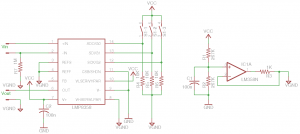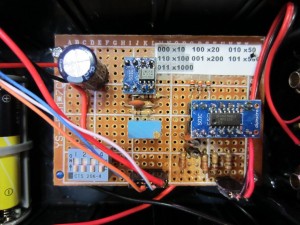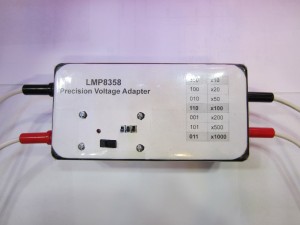A typical 3 ½ or 4 ½ multimeter can measure voltage in the low mV range and current in the low mA range. Voltage measurement in the µV range and current measurement in the nA range are typically only available in the more expensive lab bench multimeters. In this post, I will show you a simple adapter circuit that can be used for precision voltage measurement down to the µV range. Using this circuit along with the current adapter circuit I discussed earlier you will be able to perform most of the low level measurements with a 3 ½ meter.
This circuit is built around TI’s programmable precision instrumentation amplifier LMP8358. The basic circuit is quite simple and is shown below:

The gain is determined by the DIP switches and the Op-Amp LM358 forms a virtual ground circuit so that voltages of both polarities can be handled. Using both supply rails also has some additional benefits. Because either positive or negative signals can be measured, this circuit is capable of measuring AC voltages with a frequency up to 80kHz at the gain of 1000 or 8MHz with a gain of 10.
The following picture shows the actual circuit built using a protoboard. I used three AA batteries to power it so that the output can swing between -2V and 2V, which ensures high resolution for using with 3 ½ meters (2,000 counts).

The differential input impedance is 50MΩ for LMP8358, which is sufficient for most of the measurement. Higher input impedance is possible with an additional differential input stage. LMP8358 has a typical input offset voltage of 1 micro-volt, which is good enough for our purpose. This offset voltage can always be cancelled out with the “Rel” function available on most meters. Since LMP8358 is a zero-drift instrumentation Op-Amp, the output will remain accurate once the offset voltage has been zeroed out.
If you don’t like setting the gains using DIP switches, you can use an MCU to control the gain settings.

The gain accuracy is guaranteed to be within 0.25% in the worst case scenario and the typical gain accuracy is at around 0.03%. Similar circuit can also be built with other low input offset and low drift Op-Amps. The major benefit of using LMP8358 is that precision gains are guaranteed by design, without the need of using external precision resistors.
LMP8358 is a much more capable instrumentation op-amp then what we are using it for here, and you can refer to the datasheet for more information.

